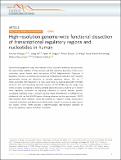| dc.contributor.author | Goggin, Sarah M. | |
| dc.contributor.author | Saadat, Alham | |
| dc.contributor.author | Wang, Li | |
| dc.contributor.author | Sinnott-Armstrong, Nasa | |
| dc.contributor.author | Wang, Xinchen | |
| dc.contributor.author | He, Liang | |
| dc.contributor.author | Kellis, Manolis | |
| dc.contributor.author | Claussnitzer, Melina | |
| dc.date.accessioned | 2019-03-26T15:50:59Z | |
| dc.date.available | 2019-03-26T15:50:59Z | |
| dc.date.issued | 2018-12 | |
| dc.identifier.issn | 2041-1723 | |
| dc.identifier.uri | http://hdl.handle.net/1721.1/121106 | |
| dc.description.abstract | Genome-wide epigenomic maps have revealed millions of putative enhancers and promoters, but experimental validation of their function and high-resolution dissection of their driver nucleotides remain limited. Here, we present HiDRA (High-resolution Dissection of Regulatory Activity), a combined experimental and computational method for high-resolution genome-wide testing and dissection of putative regulatory regions. We test ~7 million accessible DNA fragments in a single experiment, by coupling accessible chromatin extraction with self-transcribing episomal reporters (ATAC-STARR-seq). By design, fragments are highly overlapping in densely-sampled accessible regions, enabling us to pinpoint driver regulatory nucleotides by exploiting differences in activity between partially-overlapping fragments using a machine learning model (SHARPR-RE). In GM12878 lymphoblastoid cells, we find ~65,000 regions showing enhancer function, and pinpoint ~13,000 high-resolution driver elements. These are enriched for regulatory motifs, evolutionarily-conserved nucleotides, and disease-associated genetic variants from genome-wide association studies. Overall, HiDRA provides a high-throughput, high-resolution approach for dissecting regulatory regions and driver nucleotides. | en_US |
| dc.description.sponsorship | National Institutes of Health (U.S.) (R01 HG008155) | en_US |
| dc.description.sponsorship | Broad NextGen Award | en_US |
| dc.description.sponsorship | National Institutes of Health (U.S.) (R01 GM113708) | en_US |
| dc.description.sponsorship | National Institutes of Health (U.S.) (U01 HG007610) | en_US |
| dc.publisher | Nature Publishing Group | en_US |
| dc.relation.isversionof | http://dx.doi.org/10.1038/s41467-018-07746-1 | en_US |
| dc.rights | Creative Commons Attribution 4.0 International license | en_US |
| dc.rights.uri | https://creativecommons.org/licenses/by/4.0/ | en_US |
| dc.source | Nature | en_US |
| dc.title | High-resolution genome-wide functional dissection of transcriptional regulatory regions and nucleotides in human | en_US |
| dc.type | Article | en_US |
| dc.identifier.citation | Wang, Xinchen, Liang He, Sarah M. Goggin, Alham Saadat, Li Wang, Nasa Sinnott-Armstrong, Melina Claussnitzer, and Manolis Kellis. “High-Resolution Genome-Wide Functional Dissection of Transcriptional Regulatory Regions and Nucleotides in Human.” Nature Communications 9, no. 1 (December 2018). | en_US |
| dc.contributor.department | Massachusetts Institute of Technology. Computer Science and Artificial Intelligence Laboratory | en_US |
| dc.contributor.department | Massachusetts Institute of Technology. Department of Biology | en_US |
| dc.contributor.department | Massachusetts Institute of Technology. Department of Electrical Engineering and Computer Science | en_US |
| dc.contributor.mitauthor | Wang, Xinchen | |
| dc.contributor.mitauthor | He, Liang | |
| dc.contributor.mitauthor | Claussnitzer, MelinaChristine | |
| dc.contributor.mitauthor | Kellis, Manolis | |
| dc.relation.journal | Nature Communications | en_US |
| dc.eprint.version | Final published version | en_US |
| dc.type.uri | http://purl.org/eprint/type/JournalArticle | en_US |
| eprint.status | http://purl.org/eprint/status/PeerReviewed | en_US |
| dc.date.updated | 2019-03-04T14:18:51Z | |
| dspace.orderedauthors | Wang, Xinchen; He, Liang; Goggin, Sarah M.; Saadat, Alham; Wang, Li; Sinnott-Armstrong, Nasa; Claussnitzer, Melina; Kellis, Manolis | en_US |
| dspace.embargo.terms | N | en_US |
| dc.identifier.orcid | https://orcid.org/0000-0003-2450-736X | |
| mit.license | PUBLISHER_CC | en_US |
